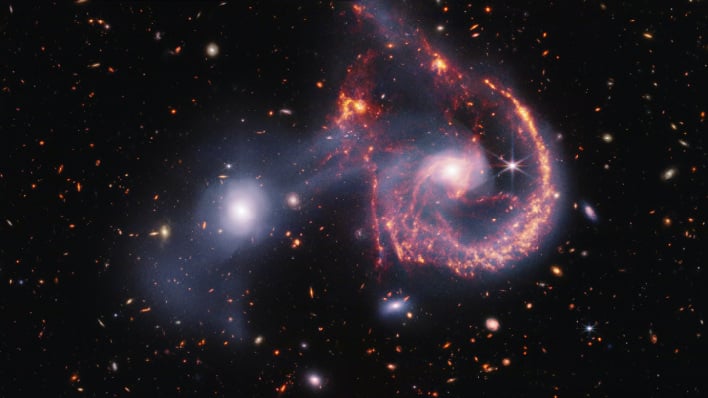
NASA’s Webb telescope tells an elliptical and spiral galaxy to say “Cheese!” The image is a composite of images, combining observations from Webb’s MIRI (Mid-Infrared Instrument) and NIRCam (Near-Infrared Camera) of a pair of galaxies collectively known as Arp 107.
The pair of galaxies, located 465 million light-years from Earth, is similar to the Cartwheel Galaxy, one of the first interacting galaxies that Webb observed. However, the spiral galaxy in Arp 107 escaped the collision with only its spiral arms being disturbed. The spiral galaxy is classified as a Seyfert galaxy, one of the two largest groups of active galaxies, along with galaxies that host quasars. Being Seyfert galaxies are not as luminous and distant as quasars, it makes them easier to study in lower energy light, such as infrared.
Webb’s NIRCam highlights the stars within both galaxies, while also revealing the connection between them: a transparent, white bridge of stars and gas pulled from both galaxies during their passage. Data from MIRI, represented in orange-red, indicates star-forming regions and dust that is composed of soot-like organic molecules known as polycyclic aromatic hydrocarbons. MIRI data also included a shot of the bright nucleus of the large spiral, which is home to a supermassive black hole.
The duo of galaxies was also observed by NASA’s Spitzer Space Telescope in 2005 (see image below). Spitzer images at 8 microns (middle picture) show a view of clumps of young stars. In the shorter wavelength 3.6 micron band (left picture), the older stars in the small companion to the northeast and the bridge connecting the two galaxies are bright. The color-coded multi-band image (right picture; red=8.0 microns, blue=3.6 microns) highlights this difference in stellar ages.

The images from Webb show the pair of galaxies in the process of merging. According to NASA, this process will take hundreds of millions of years. As the two galaxies rebuild after their collision, Arp 107 may lose its Mona Lisa smile, but it will eventually turn into something just as intriguing for future astronomers to study.